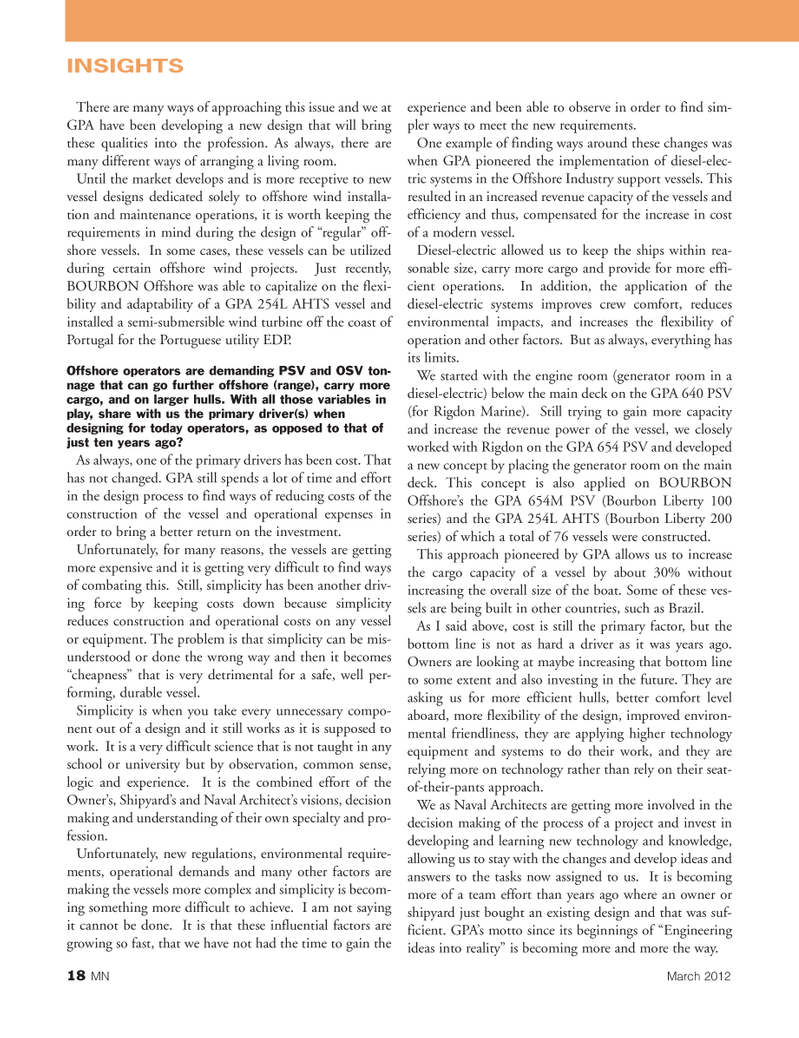
Page 18: of Marine News Magazine (March 2012)
Training & Education
Read this page in Pdf, Flash or Html5 edition of March 2012 Marine News Magazine
There are many ways of approaching this issue and we at GPA have been developing a new design that will bring these qualities into the profession. As always, there are many different ways of arranging a living room. Until the market develops and is more receptive to new vessel designs dedicated solely to offshore wind installa- tion and maintenance operations, it is worth keeping the requirements in mind during the design of ?regular? off- shore vessels. In some cases, these vessels can be utilized during certain offshore wind projects. Just recently, BOURBON Offshore was able to capitalize on the flexi- bility and adaptability of a GPA 254L AHTS vessel and installed a semi-submersible wind turbine off the coast ofPortugal for the Portuguese utility EDP. Offshore operators are demanding PSV and OSV ton- nage that can go further offshore (range), carry more cargo, and on larger hulls. With all those variables in play, share with us the primary driver(s) when designing for today operators, as opposed to that ofjust ten years ago?As always, one of the primary drivers has been cost. That has not changed. GPA still spends a lot of time and effort in the design process to find ways of reducing costs of the construction of the vessel and operational expenses in order to bring a better return on the investment. Unfortunately, for many reasons, the vessels are getting more expensive and it is getting very difficult to find ways of combating this. Still, simplicity has been another driv- ing force by keeping costs down because simplicity reduces construction and operational costs on any vessel or equipment. The problem is that simplicity can be mis- understood or done the wrong way and then it becomes ?cheapness? that is very detrimental for a safe, well per- forming, durable vessel. Simplicity is when you take every unnecessary compo- nent out of a design and it still works as it is supposed to work. It is a very difficult science that is not taught in any school or university but by observation, common sense, logic and experience. It is the combined effort of the Owner?s, Shipyard?s and Naval Architect?s visions, decision making and understanding of their own specialty and pro- fession. Unfortunately, new regulations, environmental require- ments, operational demands and many other factors are making the vessels more complex and simplicity is becom- ing something more difficult to achieve. I am not saying it cannot be done. It is that these influential factors are growing so fast, that we have not had the time to gain the experience and been able to observe in order to find sim- pler ways to meet the new requirements. One example of finding ways around these changes was when GPA pioneered the implementation of diesel-elec- tric systems in the Offshore Industry support vessels. This resulted in an increased revenue capacity of the vessels and efficiency and thus, compensated for the increase in cost of a modern vessel. Diesel-electric allowed us to keep the ships within rea- sonable size, carry more cargo and provide for more effi- cient operations. In addition, the application of the diesel-electric systems improves crew comfort, reduces environmental impacts, and increases the flexibility of operation and other factors. But as always, everything has its limits. We started with the engine room (generator room in a diesel-electric) below the main deck on the GPA 640 PSV (for Rigdon Marine). Still trying to gain more capacity and increase the revenue power of the vessel, we closely worked with Rigdon on the GPA 654 PSV and developed a new concept by placing the generator room on the main deck. This concept is also applied on BOURBON Offshore?s the GPA 654M PSV (Bourbon Liberty 100 series) and the GPA 254L AHTS (Bourbon Liberty 200 series) of which a total of 76 vessels were constructed. This approach pioneered by GPA allows us to increase the cargo capacity of a vessel by about 30% without increasing the overall size of the boat. Some of these ves- sels are being built in other countries, such as Brazil. As I said above, cost is still the primary factor, but the bottom line is not as hard a driver as it was years ago. Owners are looking at maybe increasing that bottom line to some extent and also investing in the future. They are asking us for more efficient hulls, better comfort level aboard, more flexibility of the design, improved environ- mental friendliness, they are applying higher technology equipment and systems to do their work, and they are relying more on technology rather than rely on their seat- of-their-pants approach. We as Naval Architects are getting more involved in the decision making of the process of a project and invest in developing and learning new technology and knowledge, allowing us to stay with the changes and develop ideas and answers to the tasks now assigned to us. It is becoming more of a team effort than years ago where an owner or shipyard just bought an existing design and that was suf- ficient. GPA?s motto since its beginnings of ?Engineering ideas into reality? is becoming more and more the way. 18MNMarch 2012 INSIGHTSMN#3 (18-31):MN 2011 Layouts 3/2/2012 9:22 AM Page 18

 17
17

 19
19
